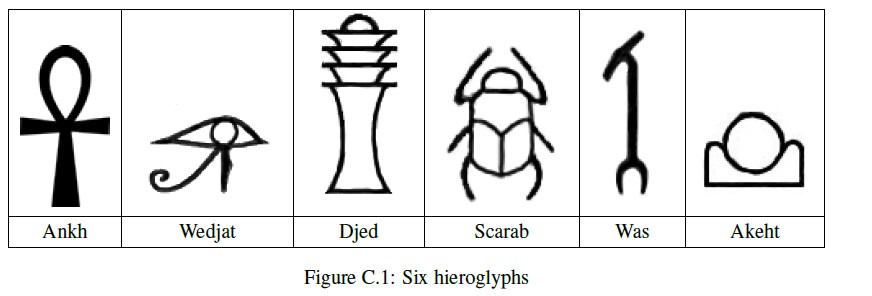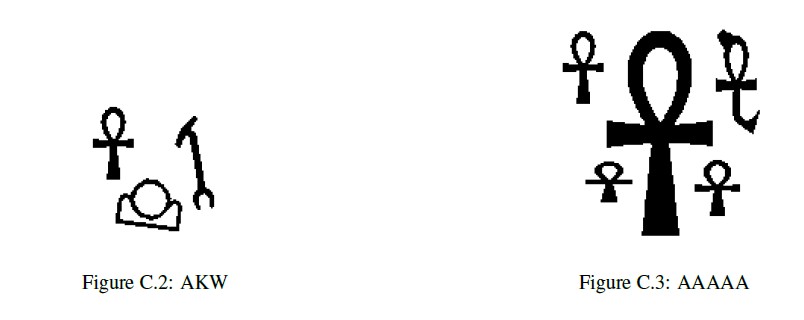HDU-3839-Ancient Messages(DFS)
hieroglyphs and their names. In this problem, you will write a program to recognize these six characters.

of black pixels (represented by 1) and white pixels (represented by 0). In the input data, each scan line is encoded in hexadecimal notation. For example, the sequence of eight pixels 10011100 (one black pixel, followed by two white pixels, and so on) would
be represented in hexadecimal notation as 9c. Only digits and lowercase letters a through f are used in the hexadecimal encoding. The first line of each test case contains two integers, H and W: H (0 < H <= 200) is the number of scan lines in the image. W
(0 < W <= 50) is the number of hexadecimal characters in each line. The next H lines contain the hexadecimal characters of the image, working from top to bottom. Input images conform to the following rules:
- The image contains only hieroglyphs shown in Figure C.1.
- Each image contains at least one valid hieroglyph.
- Each black pixel in the image is part of a valid hieroglyph.
- Each hieroglyph consists of a connected set of black pixels and each black pixel has at least one other black pixel on its top, bottom, left, or right side.
- The hieroglyphs do not touch and no hieroglyph is inside another hieroglyph.
- Two black pixels that touch diagonally will always have a common touching black pixel.
- The hieroglyphs may be distorted but each has a shape that is topologically equivalent to one of the symbols in Figure C.11.
The last test case is followed by a line containing two zeros.
1Two figures are topologically equivalent if each can be transformed into the other by stretching without tearing.
Ankh: A
Wedjat: J
Djed: D
Scarab: S
Was: W
Akhet: K
In each output string, print the codes in alphabetic order. Follow the format of the sample output.
The sample input contains descriptions of test cases shown in Figures C.2 and C.3. Due to space constraints not all of the sample input can be shown on this page.

100 25
0000000000000000000000000
0000000000000000000000000
...(50 lines omitted)...
00001fe0000000000007c0000
00003fe0000000000007c0000
...(44 lines omitted)...
0000000000000000000000000
0000000000000000000000000
150 38
00000000000000000000000000000000000000
00000000000000000000000000000000000000
...(75 lines omitted)...
0000000003fffffffffffffffff00000000000
0000000003fffffffffffffffff00000000000
...(69 lines omitted)...
00000000000000000000000000000000000000
00000000000000000000000000000000000000
0 0
Case 1: AKW
Case 2: AAAAA
思路:依据圈的数量来识别。
#include <cstdio>
#include <algorithm>
using namespace std; char ts[201],mes[6]={'W','A','K','J','S','D'},ans[10];
bool vis[205][205];
int n,m,mp[205][205],nxt[4][2]={{1,0},{0,1},{-1,0},{0,-1}},num; void dfs(int x,int y)
{
int i; for(i=0;i<4;i++)
{
x+=nxt[i][0];
y+=nxt[i][1]; if(x>=0 && x<n && y>=0 && y<m && !vis[x][y] && !mp[x][y])
{
vis[x][y]=1;
dfs(x,y);
} x-=nxt[i][0];
y-=nxt[i][1];
}
} void dfs3(int x,int y)
{
int i; for(i=0;i<4;i++)
{
x+=nxt[i][0];
y+=nxt[i][1]; if(x>=0 && x<n && y>=0 && y<m && !vis[x][y] && !mp[x][y])
{
vis[x][y]=1;
dfs3(x,y);
} x-=nxt[i][0];
y-=nxt[i][1];
}
} void dfs2(int x,int y)
{
int i; for(i=0;i<4;i++)
{
x+=nxt[i][0];
y+=nxt[i][1]; if(x>=0 && x<n && y>=0 && y<m && !vis[x][y])
{
if(mp[x][y])
{
vis[x][y]=1;
dfs2(x,y);
}
else
{
vis[x][y]=1;
num++;
dfs3(x,y);
} } x-=nxt[i][0];
y-=nxt[i][1];
}
} int main()
{
int i,j,t,casenum=1,cnt; while(~scanf("%d%d",&n,&m) && n)
{
n++;
m*=4;
m++; for(i=0;i<=n;i++) for(j=0;j<=m;j++) vis[i][j]=0; for(i=1;i<n;i++)
{
gets(ts); if(!ts[0])
{
i--;
continue;
} for(j=0;ts[j];j++)
{
if(ts[j]>='a' && ts[j]<='f')
{
t=ts[j]-'a'+10; mp[i][j*4+1]=t/8;
mp[i][j*4+2]=t%8/4;
mp[i][j*4+3]=t%4/2;
mp[i][j*4+4]=t%2/1;
}
else
{
t=ts[j]-'0'; mp[i][j*4+1]=t/8;
mp[i][j*4+2]=t%8/4;
mp[i][j*4+3]=t%4/2;
mp[i][j*4+4]=t%2/1;
}
}
} for(i=0;i<=m;i++) mp[n][i]=0;
for(i=0;i<=n;i++) mp[i][m]=0; n++;
m++; vis[0][0]=1;
dfs(0,0); cnt=0; for(i=0;i<n;i++)
{
for(j=0;j<m;j++)
{
if(mp[i][j] && !vis[i][j])
{
num=0; vis[i][j]=1; dfs2(i,j); ans[cnt++]=mes[num];
}
}
} sort(ans,ans+cnt); ans[cnt]=0; printf("Case %d: ",casenum++); puts(ans);
}
}
版权声明:本文博客原创文章,博客,未经同意,不得转载。
HDU-3839-Ancient Messages(DFS)的更多相关文章
- HDU 3839 Ancient Messages(DFS)
In order to understand early civilizations, archaeologists often study texts written in ancient lang ...
- hdu 3839 Ancient Messages (dfs )
题目大意:给出一幅画,找出里面的象形文字. 要你翻译这幅画,把象形文字按字典序输出. 思路:象形文字有一些特点,分别有0个圈.1个圈.2个圈...5个圈.然后dfs或者bfs,就像油井问题一样,找出在 ...
- K - Ancient Messages(dfs求联通块)
K - Ancient Messages Time Limit:3000MS Memory Limit:0KB 64bit IO Format:%lld & %llu Subm ...
- HDOJ(HDU).2660 Accepted Necklace (DFS)
HDOJ(HDU).2660 Accepted Necklace (DFS) 点我挑战题目 题意分析 给出一些石头,这些石头都有自身的价值和重量.现在要求从这些石头中选K个石头,求出重量不超过W的这些 ...
- HDOJ(HDU).1045 Fire Net (DFS)
HDOJ(HDU).1045 Fire Net [从零开始DFS(7)] 点我挑战题目 从零开始DFS HDOJ.1342 Lotto [从零开始DFS(0)] - DFS思想与框架/双重DFS HD ...
- HDOJ(HDU).1241 Oil Deposits(DFS)
HDOJ(HDU).1241 Oil Deposits(DFS) [从零开始DFS(5)] 点我挑战题目 从零开始DFS HDOJ.1342 Lotto [从零开始DFS(0)] - DFS思想与框架 ...
- HDOJ(HDU).1035 Robot Motion (DFS)
HDOJ(HDU).1035 Robot Motion [从零开始DFS(4)] 点我挑战题目 从零开始DFS HDOJ.1342 Lotto [从零开始DFS(0)] - DFS思想与框架/双重DF ...
- HDU 1501 Zipper 【DFS+剪枝】
HDU 1501 Zipper [DFS+剪枝] Problem Description Given three strings, you are to determine whether the t ...
- HDU 1401 Solitaire 双向DFS
HDU 1401 Solitaire 双向DFS 题意 给定一个\(8*8\)的棋盘,棋盘上有4个棋子.每一步操作可以把任意一个棋子移动到它周围四个方向上的空格子上,或者可以跳过它四个方向上的棋子(就 ...
- ACM: HDU 2563 统计问题-DFS+打表
HDU 2563 统计问题 Time Limit:1000MS Memory Limit:32768KB 64bit IO Format:%I64d & %I64u HDU 2 ...
随机推荐
- php实现求字符串第一个只出现一次的字符
php实现求字符串第一个只出现一次的字符 一.总结 很简单的逻辑 1.两个数组,一个存字母,一个存字母出现的次数 二.php实现求字符串第一个只出现一次的字符 题目描述 在一个字符串(1<=字符 ...
- php计算两个坐标直线距离
function rad($d) { return $d * 3.1415926535898 / 180.0; } function GetDistance($lat1, $lng1, $lat2, ...
- adobe-flash-player离线下载方法
https://www.neowin.net/news/adobe-flash-player-3000134 http://fpdownload.adobe.com/get/flashplayer/p ...
- [Angular Router] Lazy loading Module with Auxiliary router
Found the way to handle Auxiliary router for lazy loading moudle and erge load module are different. ...
- [tmux] Zoom and resize to view a particular pane within tmux
Sometimes you'll want to zoom in on a specific pane within a tmux window. We'll learn to use C-b z t ...
- 【z01】铺地毯
[问题描述] 为了准备一个独特的颁奖典礼,组织者在会场的一片矩形区域(可看做是平面直角坐标 系的第一象限)铺上一些矩形地毯.一共有 n 张地毯,编号从 1 到n .现在将这些地毯按照 编号从小到大的顺 ...
- Linux中特别要注意用户与文件权限的问题
1.在使用Linux中,肯定会涉及不同用户的切换,但是如果不合理切换的话,会造成很多应用启动不了,所以这时候要多多使用ll看一下文件目录的权限问题,因为如果习惯用root启动程序,然后切换普通用户继续 ...
- hibernate基本配置与简单增删改查
ORM(Object Relation Mapping)是对象关系映射,是一个思想,它的作用是在关系数据库与对象之间做一个自动映射,将数据库中的表格映射到一个类,也就是持久化类,数据表中每行映射为对象 ...
- System.nanoTime()和System.currentTimeMillis()性能问题
之前给模块做性能优化的时候,需要将性能调到毫秒级,使用了System.nanoTime()和System.currentTimeMillis()对代码分片计时分析耗时操作,后发现在串行情况下性能达 ...
- 谈谈android缓存文件
##内部存储 总是可用的 这里的文件默认是只能被你的app所访问的. 当用户卸载你的app的时候,系统会把internal里面的相关文件都清除干净. Internal是在你想确保不被用户与其他app所 ...
